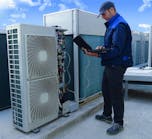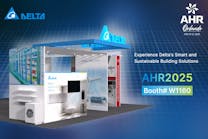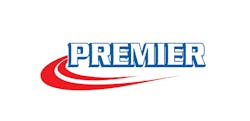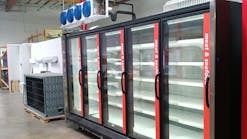Editor’s Note:This series of articles is excerpted, with permission, from the SK26-02 Service Training Package produced by Carrier Corp., Syracuse, NY. Last month (CB, May 2004) we discussed how to perform an operational check of a chiller. In this second segment, we examine what measurements to take, how to record them on the log sheet and how to analyze the data once it has been gathered.
Now that we’ve done an operational check of the chiller, it’s time to begin taking readings, recording them on a log sheet, and discussing each of the entries, starting first with the cooler section.
Chilled Water Temperature Entering the Cooler: Prior to start-up, and during initial operation, this temperature will be above the design inlet temperature. Under stabilized conditions, this temperature should drop steadily until it reaches about 54F. Read and record the entering water temperature to the cooler.
Chilled Water Temperature Leaving the Cooler: We also need to record the chilled water temperature leaving the cooler. After the chiller is placed in operation, this temperature should be within plus or minus 1F of the design leaving water temperature.
Design leaving water temperature at full load is typically 44F. Under extreme light load operation, this temperature could drop below design leaving temperature. However, a control sensing the water temperature (low water temperature cutout-recycle switch) will shut the machine down. It’s not economical, or good operating practice, to operate a chiller under extreme light load conditions, if other means, such as outside air, will accomplish the cooling job.
In our example, the reading for the design leaving water temperature is 46F
Chilled Water Delta T (Delta-T): Now we can determine the chilled water Delta T (Delta-T), which is the difference between the entering and leaving chilled water temperatures. Chilled water Delta T provides an indication of system capacity. If it’s above or below the design Delta T, a problem may exist.
In our example, the chilled water Delta T is:
54 - 46 = 8F Delta-T
Cooler Saturated Refrigerant Temperature: A space is provided on the log sheet to record the cooler saturated refrigerant temperature. Under maximum heat load conditions, with the machine operating at design, this temperature should be at the design temperature. Under reduced heat load operation, when the compressor is running unloaded, this temperature will be above design.
Under no circumstances, even at full load operation, should this temperature be allowed to drop below the design temperature, which is typically a few degrees above 32F. If the cooler saturated refrigerant temperature is at 32F or lower, then the possibility of a freeze-up exists.
If you cannot measure the actual cooler saturated refrigerant temperature, then the saturated temperature corresponding to the suction pressure may be used. This temperature is required for determining the cooler leaving temperature difference.
Suction Pressure: Read and record the suction pressure. Refer this pressure reading to a refrigerant pressure temperature chart. Compare its correlating saturated temperature to the
actual cooler saturated refrigerant temperature reading. These two temperature readings should be the same or at least very close to each other.
Cooler Leaving Temperature Difference (LTD): At this point we can calculate the cooler or Leaving Temperature Difference (LTD). This is the difference between leaving chilled water temperature and the saturated refrigerant temperature. This difference is also known as the cooler approach.
In our example, the LTD is:
46 - 40 = 6F LTD
Suction Line Temperature: This measurement is taken on the suction line near the suction service valve. Use a digital temperature probe to take this reading or read it at the control panel display, if available. Record this temperature.
Superheat: The superheat can now be calculated by subtracting the saturated cooler refrigerant temperature from the actual suction line temperature. On some units, the superheat may be read directly at the control panel display.
In our example, the superheat is:
51 - 40 = 11F SH
Record the superheat.
Chilled Water Flow: Space on the log sheet is provided to record the entering and leaving water pressures. The same gauge should be used to take both readings to ensure accuracy. The difference between the two readings indicates pressure drop or Delta P (sP). It then can be compared to the design pressure drop to determine the flow rate in gpm. If a greater than design pressure drop is recorded, there is a possibility that the tubes are either dirty, there is a restricted tube bundle, or the flow is too high.
Pressure taps for taking pressure readings across the cooler should be as close to the inlet and outlet as possible and at the same height. If there is any difference in the height of the gauges, a correction will have to be made. Now, let's look at the condenser section.
Condenser Section
Water Temperature Entering the Condenser: This temperature should not exceed the design entering water temperature, and on most installations should not drop below 70F. Entering condenser water temperature can be up to 95F, however, 85F is more typical. If the entering water temperature drops too low, the condenser head pressure will not be high enough to supply refrigerant through the expansion valve.
Water Temperature Leaving the Condenser: This temperature will vary with the heat load and/or tonnage (capacity of the machine). Under full heat load conditions, it should not exceed design. Under less than full heat load conditions, the temperature will be less than design.
Condenser Water Delta T: Next, we will find the condenser water Delta-T. Do this by subtracting the entering condenser water temperature from the leaving condenser water temperature. Condenser water Delta-T provides an indication of condenser heat rejection.
In our example, the condenser water Delta-T is:
95 - 85 = 10F Delta-T
Condenser Pressure: Record the condenser pressure. With design water temperature and water flow through the condenser tubes, and operating at full heat load conditions, this pressure should not exceed maximum design condenser pressure.
When condensing pressure is higher than design, it’s an indication that the chiller is operating inefficiently. An abnormally low condenser pressure may be an indication of a low refrigerant charge or an inefficient compressor.
Condenser Saturated Refrigerant Temperature: On some chillers, the saturated condensing temperature may be read directly at the control panel. If this is not the case, then the saturated condensing temperature is found by using a pressure/temperature chart to convert the condensing pressure to a temperature reading. This temperature is required for determining the condenser leaving temperature difference.
Condenser Leaving Temperature Difference (LTD): The condenser leaving temperature difference, or LTD, is found by subtracting the leaving condenser water temperature from the saturated condenser temperature. This also may be referred to as condenser approach.
120 - 95 = 25F LTD
Condenser Refrigerant Liquid Temperature: Measure and record the condenser refrigerant liquid temperature. If a thermometer well or control panel display is not provided to do this, strap a digital temperature probe on the bottom side of the liquid line.
Subcooling: The amount of subcooling can now be found by subtracting the liquid line temperature from the condenser saturated refrigerant temperature.
120 - 105 = 15F SC
Condenser Water Flow: Space is provided on the log sheet to record the entering and leaving water pressures. The difference between the two readings, or Delta P, indicates a pressure drop of the water flow through the condenser tubes. The same gauge should be used for both readings to insure accuracy. This pressure drop can be compared to the design pressure drop to determine flow rate in gpm, and if greater than design, there is the possibility that the tubes are either dirty, plugged or the flow is too high.
Pressure taps for taking pressure readings across the condenser should be as close to the inlet and outlet as possible and at the same height. If there is any difference in the height of the gauges, a correction will have to be made.
Air Temperature Entering Condenser:Measure and record the outdoor ambient air temperature entering the condenser. This is a very important factor on air-cooled condensers because it provides a reference to what the condenser saturated refrigerant temperature operating conditions should be.
Air Temperature Leaving Condenser: For air cooled condensers, this measurement will be useful in determining temperature rise across the condenser coil. The Delta-T can be determined by subtracting the condenser entering air temperature from the condenser leaving air temperature. The Delta-T provides an indication of the heat rejection by the condenser.
Electrical Section
Line Voltage: Measure the incoming supply voltage and record each leg-to-leg voltage (three readings); add the readings and divide by three to get an average. The average should be within 10% of the chiller nameplate voltage rating.
If any one line voltage reading is more than 2% from the average, then contact the electric utility for correction. This condition is called phase unbalance, and it should never be greater than 2%.
Motor Amperage: Using a clamp-on ammeter, record the chiller's total motor amperage. Make sure the unit has stabilized first. It should operate at least 30 minutes before taking ampere readings.
Check each power lead of the chiller, then total and average the readings. The individual amperage readings should be within 10% of the average amperage. Also, the average amperage should not exceed the design maximum.
Compressor Oil Level: On most semi-hermetic compressors, either a sight glass or bulls-eye is provided in the oil sump to determine the oil level.
The oil level should be within the sight glass. However, under certain operating conditions, a fixed oil level may not be visible due to the foaming of the oil.
In a future issue we’ll examine the symptoms of some common chiller operation problems and discuss how to correct them.








